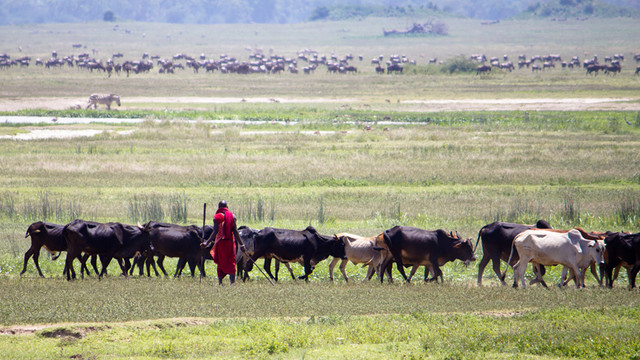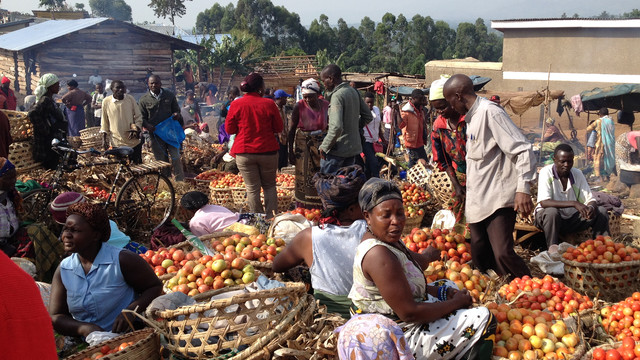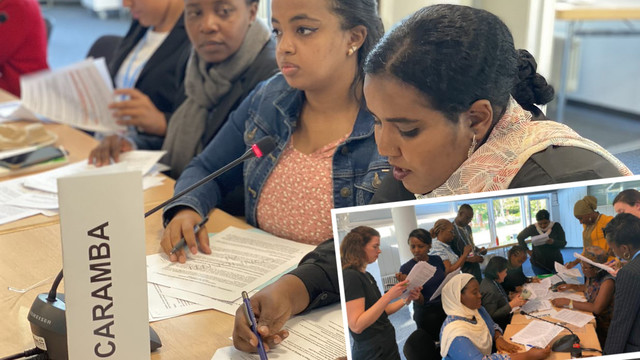Q&A: LIFE-AR in Uganda gets local climate finance flowing with decentralised model
The LDC-led LIFE-AR initiative champions ‘business unusual’ responses to the climate crisis. Uganda’s new climate finance mechanism is designed to deliver climate finance to local actors and drive a shift in power, so they decide how to plan, manage and use the funds in line with their priorities.
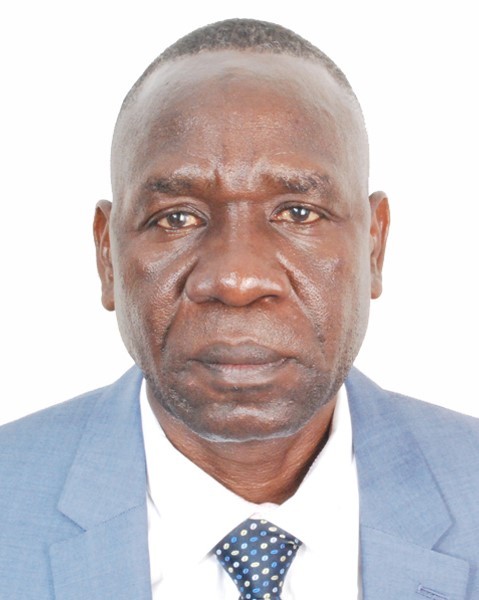 This week will see the official launch of the LIFE-AR programme in Uganda. Under the initiative, the country will promote a decentralised climate finance (DCF) mechanism. The mechanism is being designed by representatives from across the whole of society and is geared towards ensuring 70% of local and international climate finance flows to the local level – so the needs of local communities most impacted by climate change are met.
This week will see the official launch of the LIFE-AR programme in Uganda. Under the initiative, the country will promote a decentralised climate finance (DCF) mechanism. The mechanism is being designed by representatives from across the whole of society and is geared towards ensuring 70% of local and international climate finance flows to the local level – so the needs of local communities most impacted by climate change are met.
Joseph Epitu of the government’s Ministry for Water and Environment and LIFE-AR national focal point explains.
Q: The Least Developed Countries (LDCs) are showing real leadership as they develop ‘business unusual’ ways to manage the impacts of climate change. Could you explain how, under LIFE-AR, Uganda is delivering climate finance to the local level?
JE: To recap on the origins of LIFE-AR, it is an LDC-led initiative that evolved from informal discussions among the LDC Group of climate negotiators during various UN climate conventions. Access to climate finance stood out as a major challenge for LDCs. These challenges include among others: lack of capacity within countries to prepare bankable project proposals, high administration and transaction costs charged by the multilateral institutions that deliver international climate finance, and reliance on external parties for development of climate change interventions.
These obstacles spurred LDCs into developing different ways of doing things. LIFE-AR seeks to build in-country institutions, capabilities and systems to deliver climate resilience over the long term, in line with country priorities. We call this approach ‘business unusual’.
Uganda put itself forward as a ‘frontrunner’ country and, through LIFE-AR, we will focus on strengthening local governments to mobilise and manage climate finance. In line with this, we’ve designed a DCF mechanism which uses existing government structures to get local and international climate finance down to governments at the local level and out to communities who are hardest hit by the impacts of climate change.
Q: LIFE-AR calls for at least 70% of climate finance to support local-level climate action. What makes this approach so innovative?
JE: Research has shown that only around 10% of finance released by global climate finance mechanisms − such as the Green Climate Fund and The Adaptation Fund – is trickling down to local governments. LIFE-AR is trying to reverse this trend so 70% of climate finance reaches the local level.
It’s the design of this mechanism that makes this process particularly exciting − for the first time, we’re bringing local communities into the climate finance discourse.
They identify their own priorities, plan for them and manage them with the support of local government authorities; it is local communities who are coming up with sustainable long-term interventions – in place of the ‘business as usual’ short-term project-specific approaches that currently dominate the international climate finance landscape.
By getting 70% of climate finance to the grassroots, communities will be empowered to manage their own affairs; it is their needs that will take priority.
Q: How is Uganda adopting a ‘whole of society’ approach in the design of the DCF mechanism?
JE: A ‘whole of society’ approach is one of the five principles embedded in the LIFE-AR initiative. It refers to the participation of all stakeholders in the programme’s design and delivery.
In Uganda, we’re ensuring wide representation from across society in LIFE-AR’s governance structures. That includes government institutions such as the Ministry of Finance, Planning and Development, the Ministry of Local Government and Uganda Meteorological Agency, as well as representatives from local government authorities. We are also including academia from Makerere University.
Our aim is to make sure the needs of all interested parties are met and that many different perspectives inform the programme. And we’re taking very specific measures to ensure women and marginalised groups are well represented; when we’ve been communicating with the various institutions to nominate representatives for LIFE-AR governance structures, we are encouraging them to give priority to these groups.
We’re also working closely with the Ministry of Gender, Labour and Social Development. In Uganda, this is the ministry with the mandate to coordinate and manage the interests of marginalised groups. So we are ensuring that representatives from this ministry are strongly represented in the programme’s governance structure.
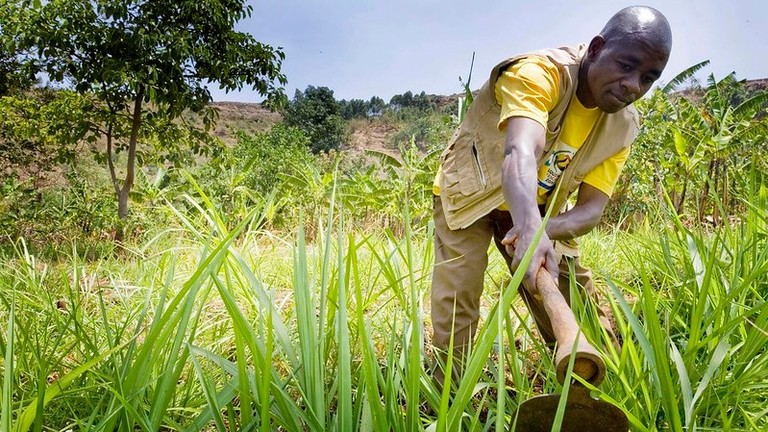
Farmer tends to his garden in Arokwo Village, Kapchorwa, Uganda (Photo: Kate Holt/Africa Practice via Flickr, CC BY 2.0)
Q: Are there pros and cons emerging from taking this type of approach? What challenges are you facing? Are any opportunities arising?
JE: One of the challenges we’re facing is linked to the very human tendency of people wanting to protect their own territories. It’s normal for people to want to own their own spaces and it can feel uncomfortable if they feel their areas is being encroached upon.
The ‘whole of society’ approach is a new concept here in Uganda and is based on the idea of bringing people together. While this supports equal representation and a feeling of unity, it can also create an element of fear. So, one challenge is to convince everyone involved that working together is the right thing for all of us.
A second challenge is around securing the participation of marginalised groups. There is a long history of women, youth and marginalised groups being side-lined in society, and they are heavily underrepresented in leadership roles. For instance, we recommend that members to the governance structures of the LIFE-AR programme be selected from officers at the level of Principal and Assistant Commissioner and above for the task team and steering committee respectively.
Unfortunately, there are very few women, and even fewer representatives from marginalised groups, who sit at this level within government. So this is a challenge we’re grappling with.
But the whole of society approach certainly brings some advantages, and opportunities to build on. By drawing together a range of disciplines we can spot synergies. We can look for opportunities to work alongside each other and in turn benefit from the strengths each institution brings. And importantly we can avoid or eliminate duplication of resources.
Another opportunity is for cross pollination of knowledge: when institutions work in silos, as they have so often done in the past, they are unaware of what others are doing. But when we work together, we can connect, we can share knowledge and skills − and ultimately leverage our strengths.
Q: LIFE-AR is launching in Uganda this week. What’s been the process leading up to the launch – and what’s next?
JE: The process started about two years ago with what we called the ‘establishment’ phase. In this phase we focused on establishing the governance structures and raising awareness about LIFE-AR and the DCF mechanism.
We began in the Ministry of Water and Environment and from there widened our reach – out to more ministries, departments, and agencies of government involved in the implementation of the programme, including academia and civil society. We recruited representatives from the above institutions into the task team who were tasked with organising and mobilising members within their institutions to raise the programme’s profile.
In the last six months, momentum has been building – and will peak at this week’s launch. We’ll be joined by our development partners including from the UK and Ireland who have supported the programme.
Crucially, we’ll be joined by representatives from the 12 districts where we plan to roll out the DCF mechanism. On the morning of the launch, substantial time will be dedicated to fully informing the district representatives about LIFE-AR and the mechanism. We will take them through the detail on how the programme operates and how its objectives have been has been designed around meeting the needs of all stakeholders across the whole of society. The district representatives will be fully up to speed before the official launch takes place in the afternoon.
A huge amount of work from across a very broad range of actors has gone into delivering this ambitious and innovative programme. But it is the input from local individuals, communities, and institutions that is so fundamental here, and a mark of the radical shift from business-as-usual to business-unusual, championed by LIFE-AR.

